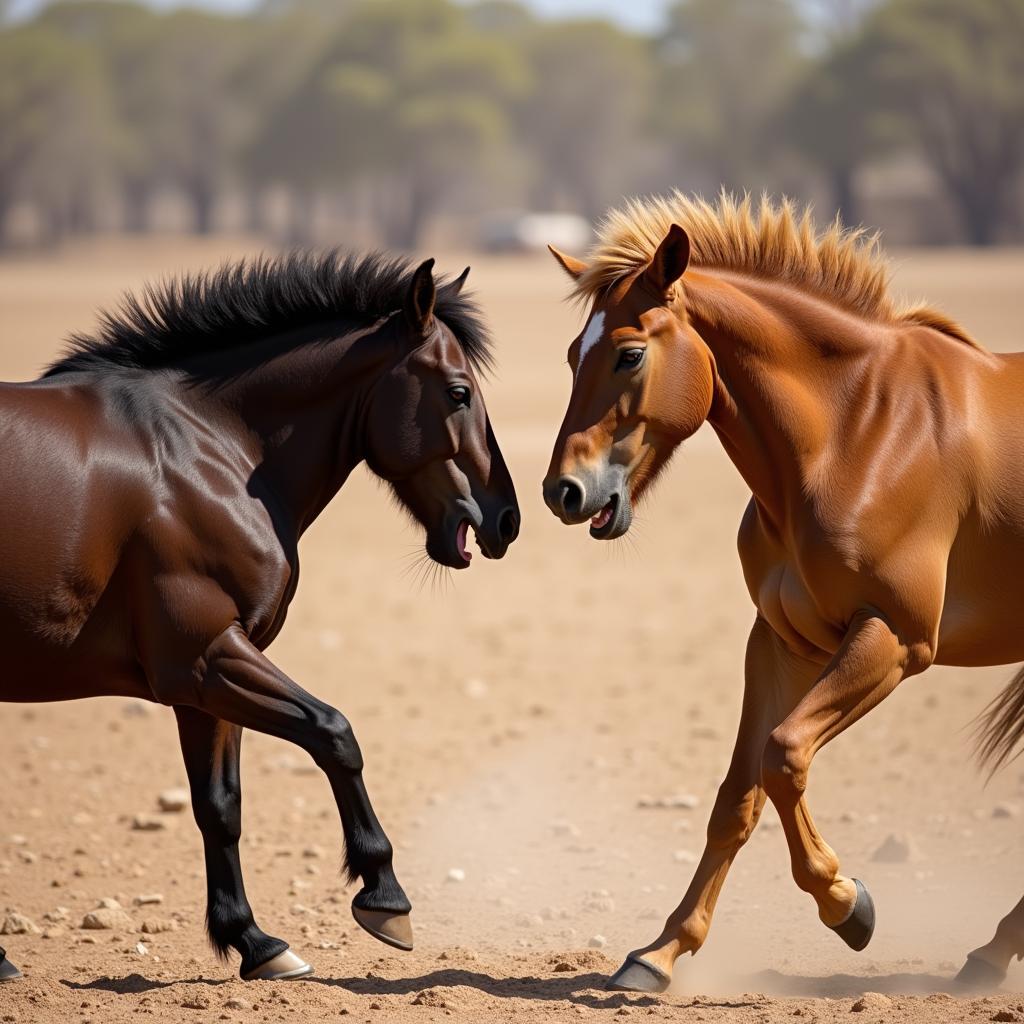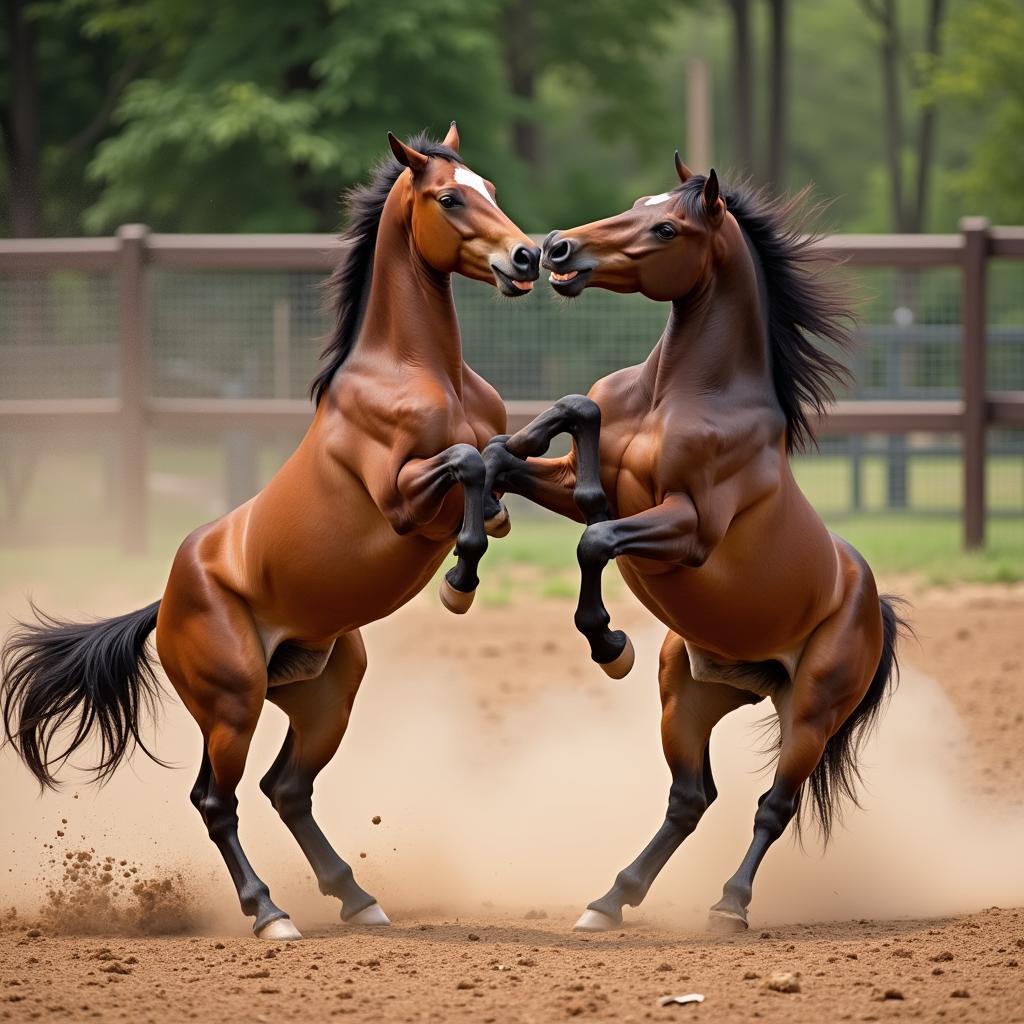Keogh Crazy Horse Fight is a search term that suggests interest in aggressive horse behavior, particularly stallion fights. While the term “crazy” doesn’t accurately reflect the nuanced nature of equine aggression, it’s important to address the underlying concerns about horse fights and how to manage them responsibly. This article delves into the reasons behind equine aggression, focusing on stallion behavior, and explores methods for preventing and managing these potentially dangerous situations.
Decoding the Dynamics of a Stallion Fight
Stallions, driven by instinct to protect their herd and breeding rights, often engage in aggressive displays. These can range from posturing and vocalizations to full-blown physical altercations. Understanding the triggers and the different levels of aggression is crucial for ensuring both horse and human safety. A “Keogh crazy horse fight” likely refers to the intensity and perceived chaos of these encounters, but it’s important to remember that these behaviors are rooted in natural instincts.
 Stallions Posturing Before a Fight
Stallions Posturing Before a Fight
Several factors can trigger stallion aggression, including the presence of mares in estrus, territorial disputes, and challenges to the established social hierarchy. These fights can be brutal, involving biting, kicking, and striking with the forelegs. While rarely fatal, serious injuries can occur, emphasizing the need for responsible management.
The Role of Hormones and Hierarchy
Testosterone plays a significant role in stallion aggression. During breeding season, testosterone levels surge, increasing the likelihood of confrontations. Establishing and maintaining a clear social hierarchy within a group of horses also influences aggression. A dominant stallion will actively defend his position, leading to challenges from younger, aspiring stallions.
 Stallions Engaged in Physical Contact
Stallions Engaged in Physical Contact
Preventing and Managing Equine Aggression
Responsible horse ownership dictates proactive measures to prevent and manage aggressive behavior. Understanding the individual horse’s temperament, providing adequate space, and implementing appropriate management strategies are essential.
- Secure Fencing: Strong, high fencing is crucial for containing stallions and preventing escapes that could lead to confrontations with other horses.
- Separate Paddocks: Keeping stallions in separate paddocks, especially during breeding season, minimizes the risk of territorial disputes.
- Controlled Introductions: If introducing new horses, do so gradually and under careful supervision. Allow the horses to interact through a fence before allowing direct contact.
Early Intervention is Key
Recognizing the early signs of aggression is crucial. Ears pinned back, flared nostrils, pawing the ground, and snapping are all indicators of escalating tension. Intervening before a physical altercation ensues is the safest approach.
Beyond “Crazy”: A Deeper Understanding of Equine Behavior
While the term “Keogh crazy horse fight” might capture the dramatic nature of stallion interactions, it’s crucial to move beyond sensationalized language and focus on understanding the underlying reasons for equine aggression. This understanding is the foundation of responsible horse ownership and ensures the safety and well-being of both horses and humans.
Conclusion: Promoting Safe and Responsible Horse Management
Understanding and managing equine aggression, particularly among stallions, is essential for responsible horse ownership. Moving beyond simplistic notions of a “Keogh crazy horse fight” and delving into the nuances of horse behavior is key to preventing dangerous situations and ensuring the well-being of these magnificent animals. By implementing appropriate management strategies and prioritizing early intervention, we can create a safer environment for both horses and humans.
FAQ
- What are the most common causes of stallion fights? Territorial disputes, competition for mares, and challenges to dominance are common triggers.
- How can I prevent stallion fights? Secure fencing, separate paddocks, and controlled introductions are key preventative measures.
- What are the signs of aggression in a stallion? Pinned ears, flared nostrils, pawing the ground, snapping, and charging are common indicators.
- Are stallion fights always dangerous? While not always fatal, stallion fights can result in serious injuries.
- What should I do if two stallions start fighting? Do not attempt to intervene directly. Try to distract them from a safe distance, and contact an experienced horse handler or veterinarian immediately.
- How can I learn more about equine behavior? Consult with a qualified equine behaviorist or explore reputable resources online and in print.
- What are the legal implications of horse fights and injuries on my property? Laws vary by region; it is crucial to understand your local regulations regarding livestock management and liability.
For further assistance regarding horse care and management, please contact us at Phone Number: 0772127271, Email: [email protected] or visit us at QGM2+WX2, Vị Trung, Vị Thuỷ, Hậu Giang, Vietnam. We offer 24/7 customer support. We also have articles on horse training, horse nutrition and general horse care tips. Check them out for more valuable information.